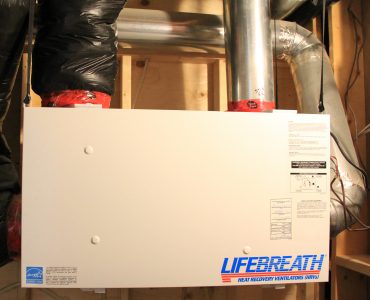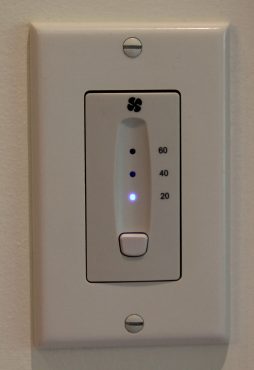
John Bleasby
Does a house need to ‘breathe’? Can it be too tight?
Canadian ContractorAre you confused about the purpose of an HRV system?
You built exactly what the clients wanted: a ‘tight’ house with lots of insulation, thermal breaks, and high quality Low-E windows. Anything missing? Yes!
That tight house may be a great thermal package, but without a controlled system to deal with the air inside, it can be a trap for high humidity, pollutants and staleness. It can breed an environment that allows mold to grow, a serious issue with many new ‘tight’ houses. That’s why there’s HRV’s (Heat Recovery Ventilation systems). Yet while many local and regional codes require new houses to be equipped with an HRV, a surprising number of contractors and renovators remain unsure of the HRV’s function and importance, and therefore cannot properly explain the benefits to their clients.

An HRV is a sophisticated air control system. Here’s what it does.
It’s critical that contractors understand that an HRV is not the same as an attic fan, not the same as a heat pump, not the same as switching the furnace fan ‘on’, and not the same as high powered bathroom ventilation fans. They are an air control system all to themselves.
Homes don’t breathe; people do.
Some traditionalists claim homes should ‘breathe’. That’s a nice way of saying they should ‘leak air’. They might rationalize that kind of nonsense by suggesting that a house that breathes allows the building and its materials to dry out, or keeps the interior atmosphere healthy because old air is replaced by new air. However, cracks in window sills or exterior door casings that allow drafts are no substitute for a ventilation system. Leaks are uncontrolled, and allow warm air to exit and cold air to enter. That not only promotes mold growth; it wastes energy.
What does an HRV actually do?
An HRV running continuously will exhaust stale, polluted and humid air and introduce fresh dry warm air into the home’s atmosphere. It transfers heat from that stale damp exhaust air to preheat the fresh incoming air, thus reducing condensation that can cause mold and mildew.

The HRV unit is usually installed in the basement, and is isolated from studs and ducting to reduce room-to-room noise transmission. Note how this unit is suspended with straps from the ceiling joists above.
(photo: John Bleasby)
Understand the distinction between an HRV and everything else
It’s a mistake to confuse an HRV with any other mechanical system that moves the air or the simple action of opening a window. Canada’s climate means homes are closed up for prolonged periods during the winter. Recycling the heat captured in exhaust air reduces heat waste. This is when an HRV is really important. It allows fresh air to replace old air without the heat loss that occurs with vents and open windows. Even in the summer, homes equipped with standard air conditioners can benefit. Standard A/C’s simply recirculate existing air while cooling it. In combination with an HRV, that cool air can be cool fresh air.
HRV systems are not inexpensive and require their own ducting. However, this offers the opportunity to use HRV vents and controls in bathrooms and laundry rooms as efficient odour/moisture ventilation systems in place of traditional room exhaust vent systems, since most quality HRV systems can include individual room controllers that allow a manual overrides of 20-40-60 minute periods with the push of a button.

An individual HRV control in a bathroom or laundry room can override the pre-settings on the main control to provide immediate ventilation in 20-40-60 minutes segments
(photo: John Bleasby)
Yes…Size matters!
Correct sizing to suit the interior volume of the house is important. This is not a place to skimp. Too small a unit will mean running at high speeds more often. That in turn means higher operating costs, more cleaning maintenance, and possible noise issues. It’s better to over-size and have the unit running quietly at lower speeds. Issues like that might have led to some on-line commentary from a Canadian Contractor reader complaining about the noise of their HRV system (ref. Part Five: The Road the NZE) and was apparently told by her contractor to switch it ‘off’ it bothered them. That is no solution and contradicts the point of having an HRV in the first place. In response, an HRV professional offered this sensible advice.
“It’s a requirement for these units to be very quiet and properly installed as to not transmit any mechanical noise into the walls,” he wrote. The commenter also offered some solid advice for any contractor involved in the specification or installation of an HRV. “Pick a quiet unit to begin with, mechanically isolate it from the walls it is mounted on (i.e. hang it on extra studs that are not coupled to the drywall, or special rubber de-couplers —hanging a unit by a chain can still transfer noise into the ceiling, unless you have springs in there, even then it may still transfer noise through the ducting etc. . Use absorbers in your supply and return lines, the noise can travel upstream through the ducting. “
No matter what heating system or heat source is selected by your clients, modern homes built to code, especially those built with Net Zero Energy or Passive House concepts in mind, must have an appropriate HRV system working in tandem. It’s all about air quality, and that impacts both the building and its occupants.
Follow John on Instagram and on Twitter for notifications about our newest posts
Advertisement
Print this page


Hello John,
I appreciate your posts and following them very closely, but this time I would like to give my input to your section “Homes don’t breathe: people do”. By saying a house should ‘breathe’ is noting wrong, that does not mean a house should have ‘air leaks’ at all!
A real breathing home has a permeable wall/roof system which can not be provided with any foam insulation and petroleum based membrane products, these can only be achieved with “real green and sustainable” products like wood fibre insulation and similar products.
All of as were told as a toddler ‘do never put a plastic bag over your head, you won’t survive’, right? Why then do we want to leave in a ‘plastic bag moister trap home’ instead in a comfortable and healthy environment?
Nevertheless, a great air ventilation system is a great asset.
You might should also consider possibilities of “green” products since those letters are already a part of your contact.
Sincerely, Andreas
Hi! I am grasping at straws and your website came up in a search. I have a very tight home with closed foam and a lifebreath hrv concentric system. I have it running amd still get high levels of co2, 1100+. No one in area for hvac professionals knows why since it is installed properly. Cannot provide any thoughts? My husband has lyme disease and is sensitive to bad air quality. Thank you for your time.